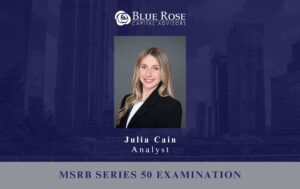April 30, 2025 | Brandon Lippold, Vice President, and Max Wilkinson, Vice President
Leveraging Debt for Campus Improvement: A Strategic Guide for Higher Education Institutions
In the ever-evolving landscape of higher education, institutions face mounting pressure to maintain and modernize their campuses with limited financial resources. From addressing aging infrastructure to expanding facilities for future growth, campus improvement is an essential but costly priority. One effective way colleges and universities can meet these capital needs is through the strategic use of debt. Blue Rose presented on this topic in April 2025 alongside CliftonLarsonAllen (CLA). This article provides a high-level overview of how higher education institutions can leverage debt effectively from a variety of perspectives. For more detail, we encourage you to view the replay of our webinar
here.
Campus Modernization and Capital Needs
The higher education sector faces an increasingly competitive market environment, the product of fewer students entering college each year (the so-called “demographic cliff”) combined with a sharper demand for modernized facilities. Against this backdrop, many colleges and universities already struggle to address the backlog of deferred maintenance and aging infrastructure, which can hinder both operational efficiency and the student experience. There is also a backlog in capital spending from the COVID era as uncertainty led colleges and universities to pull back for several years. For example, some higher education institutions struggle to house all students who wish to live on campus with their existing housing inventory, potentially missing out on revenue-generating opportunities as a result.
To finance these capital needs, institutions typically rely on a mix of funding sources, including debt financing, capital campaigns, operating cashflow, unrestricted investments, or some combination of these alternatives. That mixture depends on the urgency of the capital needs, the opportunity costs of investments, the time required to accumulate cash or pledges, and the strength of the institution’s operational performance. Maintaining a manageable level of debt can be a means of preserving liquidity in a challenging environment for the sector. Additionally, access to the tax-exempt capital markets allows borrowers to issue debt at an attractive cost of capital relative to historical endowment returns, with tax-exempt rates trending meaningfully below long-term net annualized endowment returns (which have consistently exceeded 6% over the past 5-, 10-, 15-, 20-, and 25-year time horizons, according to the 2024 NACUBO-Commonfund Study of Endowments). The flexibility of such debt allows higher education institutions to “keep their powder dry,” maintaining unrestricted fund balances to be prepared for the many headwinds, expected and unexpected, that continue to face the sector.
Purposeful Debt Management
Purposeful debt management begins with crafting a debt profile that supports long-term institutional goals while preserving financial health. Colleges and universities can manage their debt profiles by structuring debt service requirements that “step down” over time to preserve future borrowing capacity. Other borrowers may structure new issuances to “wrap” them around existing debt, maintaining a level debt service structure within the portfolio over time. Alternatively, some institutions may prefer large “balloon” maturities over traditional amortizing structures, incurring only interest expense and seeking to fully leverage the benefits of a tax-exempt cost of capital until a large principal payment becomes due at final maturity. Any structure, however, must first consider debt service payments from the perspective of cashflow affordability for the institution. While bond structuring tools such as capitalized interest can reduce short-term debt service impact of new issuance, over the long run such methods generally come with additional cost. It is crucial for borrowers to plan carefully to ensure that they are prepared to meet debt service obligations over time for any new issuance.
Debt Structuring and Credit Quality Considerations
Credit strength plays an important role in how much flexibility borrowers have in managing debt obligations, as well as their cost of borrowing. For these and other reasons, colleges and universities should closely consider how potential debt issuances will affect their credit quality. Credit rating agencies like Moody’s, S&P, and Fitch have developed comprehensive rating methodologies to evaluate a variety of key financial metrics, including liquidity, operating performance, debt service coverage, and other quantitative and qualitative metrics, to arrive at a final credit rating outcome for the institutions they rate. These methodologies can be utilized to evaluate how new debt might affect a credit rating. In some cases, a college or university may be willing to take the risk of a credit rating downgrade as the result of debt issuance to enable strategic investments that will promote its mission. When possible, however, it is a prudent strategy to try to maintain strong credit ratings, both as a sign of overall institutional financial strength and as a driver for lower future borrowing costs.
Conclusion
Leveraging debt to fund campus improvements can be a complex part of the overall financial strategy for many colleges and universities. By carefully considering funding sources, managing their overall debt portfolios strategically, and carefully considering the credit impact of their financing plans, higher education institutions can position themselves for long-term financial health and promote their mission with intentional investment in projects to improve their campuses. If you have questions about how to address existing debt or future contemplated borrowing as part of your campus strategic planning, we encourage you to reach out to your Blue Rose advisor for further discussion.



